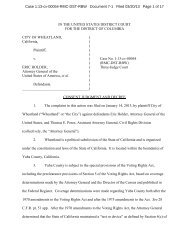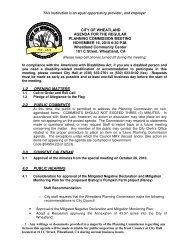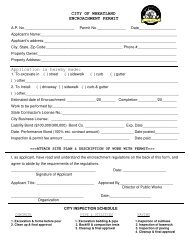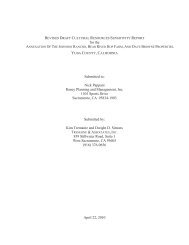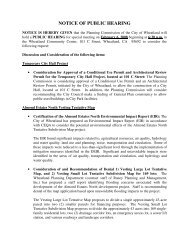General Plan Policy Document (Adopted 7-11 ... - City of Wheatland
General Plan Policy Document (Adopted 7-11 ... - City of Wheatland
General Plan Policy Document (Adopted 7-11 ... - City of Wheatland
Create successful ePaper yourself
Turn your PDF publications into a flip-book with our unique Google optimized e-Paper software.
LAND USE AND COMMUNITY CHARACTER, Chapter 1 MOREINFO...Gross acreage includes allland (including proposedstreets and rights-<strong>of</strong>-way)designated for a particularresidential use. Grossacreage is a standard that ismore typically used ingeneral plans.Net acreage excludesexisting and proposedstreets, rights-<strong>of</strong>-ways,drainage areas, and otherpublic facilities such asschools, parks, andgreenbelts. In urban areas,net acreage is normally 20to 25 percent less than grossacreage. In rural areas andopen space areas, thedifference between net andgross can be as low as 5percent. Net acreage is thestandard typically used inzoning ordinances.assumed for the applicable residential designation. Standards <strong>of</strong>building intensity for residential uses are stated as the allowablerange <strong>of</strong> dwelling units per gross acre.The assumed average number <strong>of</strong> persons per dwelling unit for eachresidential designation has been extrapolated from population andhousing unit estimates prepared by the Sacramento Area Council<strong>of</strong> Governments (SACOG) and the State <strong>of</strong> California Department<strong>of</strong> Finance. These are summarized in Table 1-1 following thedescriptions <strong>of</strong> the land use designations. It is important to notethat the average person per dwelling unit figures cited under eachresidential designation do not represent <strong>City</strong> policy; they simplyprovide the basis for correlating the permitted number <strong>of</strong> dwellingunits per acre with the potential residents <strong>of</strong> those units.NON-RESIDENTIAL USESStandards <strong>of</strong> building intensity for non-residential uses in the<strong>General</strong> <strong>Plan</strong> are stated as maximum floor-area ratios (FARs). Afloor-area ratio is the ratio <strong>of</strong> the gross building square footage on alot to the net square footage <strong>of</strong> the lot.For example, on a lot with 10,000 net square feet <strong>of</strong> land area, aFAR <strong>of</strong> 1.00 will allow 10,000 square feet <strong>of</strong> gross building floorarea to be built, regardless <strong>of</strong> the number <strong>of</strong> stories in the building(e.g., 5,000 square feet per floor on two floors or 10,000 square feeton one floor). On the same lot, a FAR <strong>of</strong> 0.50 would allow 5,000square feet <strong>of</strong> floor area, and a FAR <strong>of</strong> 0.25 would allow 2,500square feet. The diagram to the left illustrates conceptually howbuildings <strong>of</strong> one, two, and four stories could be developed on agiven lot with a FAR <strong>of</strong> 1.00.Standards <strong>of</strong> population density for non-residential uses can bederived by multiplying one acre (43,560 square feet) by theapplicable FAR and then dividing by the assumed average squarefootage <strong>of</strong> building area per employee. The assumed averagesquare footage <strong>of</strong> nonresidential building floor area per employeeis based on historic averages and market studies. These aresummarized in Table 1-1 following the descriptions <strong>of</strong> the land usedesignations. It is important to note that the average employeedensity figures cited under each nonresidential designation do notrepresent <strong>City</strong> policy; they simply provide the basis for correlatingthe permitted FAR with the potential number <strong>of</strong> employees innonresidential development.<strong>Wheatland</strong> <strong>General</strong> <strong>Plan</strong> <strong>Policy</strong> <strong>Document</strong>, Part II 1-2July <strong>11</strong>, 2006



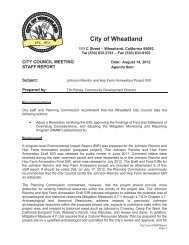
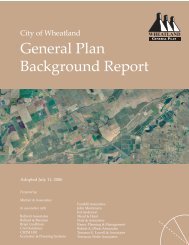
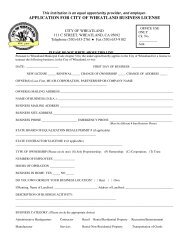
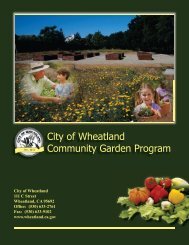
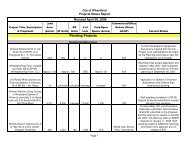
![[Read-Only].pdf - City of Wheatland - State of California](https://img.yumpu.com/37333564/1/190x146/read-onlypdf-city-of-wheatland-state-of-california.jpg?quality=85)
